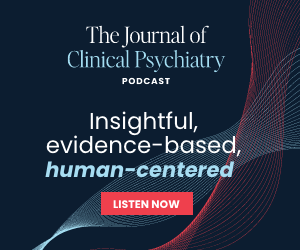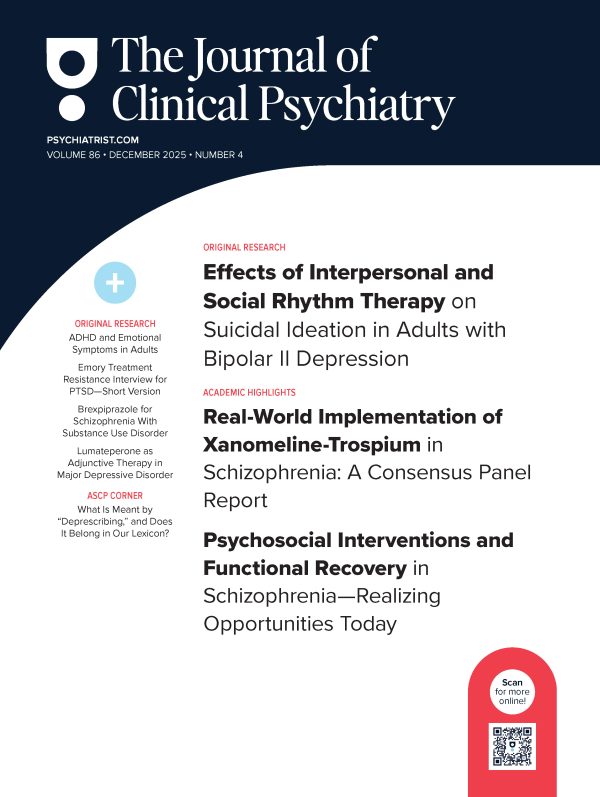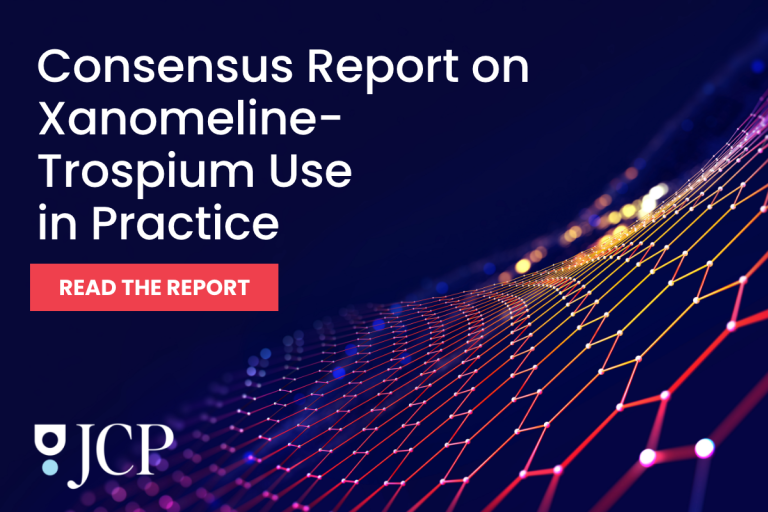
ABSTRACT
Objective: To compare well-baby visit and vaccination schedule adherence up to age 24 months in children of mothers with versus without schizophrenia.
Methods: Using administrative health data on births in Ontario, Canada (2012–2016), children of mothers with schizophrenia (ICD-9: 295; ICD-10: F20/F25; DSM-IV schizophrenia or schizoaffective disorder) (n = 1,275) were compared to children without maternal schizophrenia (n = 520,831) on (1) well-baby visit attendance, including an enhanced well-baby visit at age 18 months, and (2) vaccine schedule adherence for diphtheria, tetanus, pertussis, polio, Haemophilus influenzae type B (DTaP-IPV-Hib), and measles, mumps, rubella (MMR). Cox proportional hazard regression models were adjusted for each of maternal sociodemographics, maternal health, and child health characteristics in blocks and all together in a fully adjusted model.
Results: About 50.3% of children with maternal schizophrenia had an enhanced 18-month well-baby visit versus 58.6% of those without, corresponding to 29.0 versus 33.9 visits/100 person-years (PY), a hazard ratio (HR) of 0.82 (95% CI, 0.76–0.89). The association was dampened after adjustment for maternal sociodemographics, maternal health, and child health factors in blocks and overall, with a fully adjusted HR of 0.91 (95% CI, 0.84–0.98). Full vaccine schedule adherence occurred in 40.0% of children with maternal schizophrenia versus 46.0% of those without (22.6 vs 25.9/100 PY), yielding a HR of 0.86 (95% CI, 0.78–0.94). The association was dampened when adjusted for maternal sociodemographics and child health characteristics and became nonsignificant when adjusted for maternal health characteristics. The fully adjusted HR was 0.95 (95% CI, 0.87–1.04).
Conclusions: Increased efforts to ensure that children with maternal schizophrenia receive key early preventive health care services are warranted.
Members Only Content
This full article is available exclusively to Professional tier members. Subscribe now to unlock the HTML version and gain unlimited access to our entire library plus all PDFs. If you’re already a subscriber, please log in below to continue reading.
References (55)

- WHO CoSDoHWHO. Closing the Gap in a Generation: Health Equity Through Action on the Social Determinants of Health: Commission on Social Determinants of Health Final Report. World Health Organization; 2008.
- Record RB. Ottawa: Canadian Paediatric Society. CPS website. www.cps.ca/en/tools-outils/rourke-baby-record. Updated November 17, 2017. Accessed August 31, 2020.
- Williams R, Clinton J. Canadian Paediatric Society, Early Years Task Force. Getting it right at 18 months: in support of an enhanced well-baby visit. Paediatr Child Health. 2011;16(10):647–654. PubMed CrossRef
- Bocquier A, Ward J, Raude J, et al. Socioeconomic differences in childhood vaccination in developed countries: a systematic review of quantitative studies. Expert Rev Vaccines. 2017;16(11):1107–1118. PubMed CrossRef
- Gidding HF, Flack LK, Sheridan S, et al; ACIR linkage Investigator Team. Infant, maternal and demographic predictors of delayed vaccination: a population-based cohort study. Vaccine. 2020;38(38):6057–6064. PubMed CrossRef
- Gilbert NL, Gilmour H, Wilson SE, et al. Determinants of non-vaccination and incomplete vaccination in Canadian toddlers. Hum Vaccin Immunother. 2017;13(6):1–7. PubMed CrossRef
- Guttmann A, Saunders NR, Kumar M, et al. Implementation of a physician incentive program for 18-month developmental screening in Ontario, Canada. J Pediatr. 2020;226:213–220.e1. PubMed CrossRef
- Périnet S, Kiely M, De Serres G, et al. Delayed measles vaccination of toddlers in Canada: associated socio-demographic factors and parental knowledge, attitudes and beliefs. Hum Vaccin Immunother. 2018;14(4):868–874. PubMed CrossRef
- Van Berckelaer AC, Mitra N, Pati S. Predictors of well child care adherence over time in a cohort of urban Medicaid-eligible infants. BMC Pediatr. 2011;11(1):36. PubMed CrossRef
- Guttmann A. Uptake of Ontario’s Enhanced 18-Month Well-Baby Visit: An AHRQReport. Institute for Clinical Evaluative Sciences; 2016.
- Goldner EM, Hsu L, Waraich P, et al. Prevalence and incidence studies of schizophrenic disorders: a systematic review of the literature. Can J Psychiatry. 2002;47(9):833–843. PubMed CrossRef
- Vigod SN, Seeman MV, Ray JG, et al. Temporal trends in general and age-specific fertility rates among women with schizophrenia (1996–2009): a population-based study in Ontario, Canada. Schizophr Res. 2012;139(1–3):169–175. PubMed CrossRef
- Howard LM, Kumar R, Thornicroft G. Psychosocial characteristics and needs of mothers with psychotic disorders. Br J Psychiatry. 2001;178(5):427–432. PubMed CrossRef
- Hameed MA, Lewis AJ. Offspring of parents with schizophrenia: a systematic review of developmental features across childhood. Harv Rev Psychiatry. 2016;24(2):104–117. PubMed CrossRef
- Vigod SN, Kurdyak PA, Dennis CL, et al. Maternal and newborn outcomes among women with schizophrenia: a retrospective population-based cohort study. BJOG. 2014;121(5):566–574. PubMed CrossRef
- Henriksson KM, McNeil TF. Health and development in the first 4 years of life in offspring of women with schizophrenia and affective psychoses: Well-Baby Clinic information. Schizophr Res. 2004;70(1):39–48. PubMed CrossRef
- Sanchez-Gistau V, Romero S, Moreno D, et al. Psychiatric disorders in child and adolescent offspring of patients with schizophrenia and bipolar disorder: a controlled study. Schizophr Res. 2015;168(1-2):197–203. PubMed CrossRef
- Taylor CL, Stewart R, Ogden J, et al. The characteristics and health needs of pregnant women with schizophrenia compared with bipolar disorder and affective psychoses. BMC Psychiatry. 2015;15(1):88. PubMed CrossRef
- Howard LM, Thornicroft G, Salmon M, et al. Predictors of parenting outcome in women with psychotic disorders discharged from mother and baby units. Acta Psychiatr Scand. 2004;110(5):347–355. PubMed CrossRef
- Howard LM, Goss C, Leese M, et al. Medical outcome of pregnancy in women with psychotic disorders and their infants in the first year after birth. Br J Psychiatry. 2003;182(1):63–67. PubMed CrossRef
- Osam CS, Pierce M, Hope H, et al. The influence of maternal mental illness on vaccination uptake in children: a UK population-based cohort study. Eur J Epidemiol. 2020;35(9):879–889. PubMed CrossRef
- Williams R, Clinton J, Price D, et al. Ontario’s enhanced 18-month well-baby visit: program overview, implications for physicians. Ont Med Rev. 2010;2:23–27.
- Maaten S, Guttman A, Kopp A, et al. Care of women during pregnancy and childbirth. Primary Care in Ontario ICES Atlas Toronto: Institute for Clinical Evaluative. Toronto: Institute for Clinical Ecaluative Sciences; 2006.
- Williams J, Young W. A summary of studies on the quality of health care administrative databases in Canada. Patterns of Health Care in Ontario: the ICES Practice Atlas. 2nd ed. Ottawa: Canadian Medical Association; 1996;339:45.
- Schwartz KL, Tu K, Wing L, et al. Validation of infant immunization billing codes in administrative data. Hum Vaccin Immunother. 2015;11(7):1840–1847. PubMed CrossRef
- Kurdyak P, Lin E, Green D, et al. Validation of a population-based algorithm to detect chronic psychotic illness. Can J Psychiatry. 2015;60(8):362–368. PubMed CrossRef
- Minkovitz CS, Strobino D, Scharfstein D, et al. Maternal depressive symptoms and children’s receipt of health care in the first 3 years of life. Pediatrics. 2005;115(2):306–314. PubMed CrossRef
- Farr SL, Dietz PM, Rizzo JH, et al. Health care utilisation in the first year of life among infants of mothers with perinatal depression or anxiety. Paediatr Perinat Epidemiol. 2013;27(1):81–88. PubMed CrossRef
- Bland J, Clements J. Protecting the world’s children: the story of WHO’s immunization programme. World Health Forum. 1998;19(2):162–173. PubMed
- Ontario PH. Publicly Funded Immunization Schedules for Ontairo. Health.gov website. https://www.health.gov.on.ca/en/pro/programs/immunization/docs/Publicly_Funded_ImmunizationSchedule.pdf. Accessed December 27, 2021.
- Johns Hopkins University. The Johns Hopkins ACG System. Q-corp.org website. https://q-corp.org/sites/qcorp/files/Johns%20Hopkins%20ACG%20System.pdf. 2012. Accessed August 31, 2020.
- Saunders NR, Ray JG, Diong C, et al. Primary care of mothers and infants by the same or different physicians: a population-based cohort study. CMAJ. 2020;192(36):E1026–E1036. PubMed CrossRef
- Arat A, Burström B, Östberg V, et al. Social inequities in vaccination coverage among infants and pre-school children in Europe and Australia: a systematic review. BMC Public Health. 2019;19(1):290. PubMed CrossRef
- Arat A, Norredam M, Baum U, et al. Organisation of preventive child health services: key to socio-economic equity in vaccine uptake? Scand J Public Health. 2020;48(5):491–494. PubMed CrossRef
- McLeod L, Buckley G, Sweetman A. Ontario primary care models: a descriptive study. CMAJ Open. 2016;4(4):E679–E688. PubMed CrossRef
- Feudtner C, Feinstein JA, Zhong W, et al. Pediatric complex chronic conditions classification system version 2: updated for ICD-10 and complex medical technology dependence and transplantation. BMC Pediatr. 2014;14(1):199. PubMed CrossRef
- Liu N, Farrugia MM, Vigod SN, et al. Intergenerational abortion tendency between mothers and teenage daughters: a population-based cohort study. CMAJ. 2018;190(4):E95–E102. PubMed CrossRef
- Bursac Z, Gauss CH, Williams DK, et al. Purposeful selection of variables in logistic regression. Source Code Biol Med. 2008;3(1):17. PubMed CrossRef
- Lyngsøe BK, Vestergaard CH, Rytter D, et al. Attendance of routine childcare visits in primary care for children of mothers with depression: a nationwide population-based cohort study. Br J Gen Pract. 2018;68(667):e97–e104. PubMed CrossRef
- Dias CC, Figueiredo B. Breastfeeding and depression: a systematic review of the literature. J Affect Disord. 2015;171:142–154. PubMed CrossRef
- Kavanaugh M, Halterman JS, Montes G, et al. Maternal depressive symptoms are adversely associated with prevention practices and parenting behaviors for preschool children. Ambul Pediatr. 2006;6(1):32–37. PubMed CrossRef
- Zajicek-Farber ML. The contributions of parenting and postnatal depression on emergent language of children in low-income families. J Child Fam Stud. 2010;19(3):257–269. CrossRef
- Jones MN, Brown CM, Widener MJ, et al. Area-level socioeconomic factors are associated with noncompletion of pediatric preventive services. J Prim Care Community Health. 2016;7(3):143–148. PubMed CrossRef
- Kaufman EA, McDonell MG, Cristofalo MA, et al. Exploring barriers to primary care for patients with severe mental illness: frontline patient and provider accounts. Issues Ment Health Nurs. 2012;33(3):172–180. PubMed CrossRef
- Dolman C, Jones I, Howard LM. Pre-conception to parenting: a systematic review and meta-synthesis of the qualitative literature on motherhood for women with severe mental illness. Arch Women Ment Health. 2013;16(3):173–196. PubMed CrossRef
- Guttmann A, Manuel D, Dick PT, et al. Volume matters: physician practice characteristics and immunization coverage among young children insured through a universal health plan. Pediatrics. 2006;117(3):595–602. PubMed CrossRef
- Guttmann A, Shipman SA, Lam K, et al. Primary care physician supply and children’s health care use, access, and outcomes: findings from Canada. Pediatrics. 2010;125(6):1119–1126. PubMed CrossRef
- Gearing RE, Alonzo D, Marinelli C. Maternal schizophrenia: psychosocial treatment for mothers and their children. Clin Schizophr Relat Psychoses. 2012;6(1):27–33. PubMed CrossRef
- Radley J, Grant C, Barlow J, et al. Parenting interventions for people with schizophrenia or related serious mental illness. Cochrane Database Syst Rev. 2021 Oct 19;10(10):CD013536. PubMed CrossRef
- Holt N, Mygind A, Bro F. Danish MMR vaccination coverage is considerably higher than reported. Dan Med J. 2017;64(2):A5345. PubMed
- Mayer-Amberg N, Woltmann R, Walther S. An integrated care initiative to improve patient outcome in schizophrenia. Front Psychiatry. 2016;6:184. PubMed CrossRef
- Glazer KB, Zeitlin J, Howell EA. Intertwined Disparities: Applying the Maternal-Infant Dyad Lens to Advance Perinatal Health Equity. Elsevier; 2021:151410.
- Wan MW, Moulton S, Abel KM. A review of mother-child relational interventions and their usefulness for mothers with schizophrenia. Arch Women Ment Health. 2008;11(3):171–179. PubMed CrossRef
- Moore Simas TA, Flynn MP, Kroll-Desrosiers AR, et al. A systematic review of integrated care interventions addressing perinatal depression care in ambulatory obstetric care settings. Clin Obstet Gynecol. 2018;61(3):573–590. PubMed CrossRef
- Wendt AC, Stamper G, Howland M, et al. Indirect psychiatric consultation for perinatal bipolar disorder: a scoping review. Gen Hosp Psychiatry. 2021;68:19–24. PubMed CrossRef





